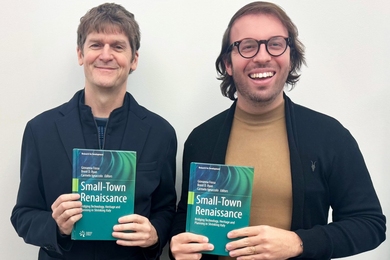From "A National Mission: A Special Report from the Office of MIT President Charles M. Vest," a supplement included with the December 10, 1997 issue of MIT Tech Talk.
When asked to discuss the impact of Federal cost-shifting and changing budget priorities on their research efforts, MIT faculty members expressed concern tinged with cautious optimism. Most share the view of Nobel Laureate Phillip A. Sharp, head of the MIT department of biology, that "the tree of science ... must be protected and nurtured over long periods to be rewarded with great fruit." Yet some researchers also note that securing and accounting for federal dollars takes more and more of their time--time they hope could be devoted to the actual work of research and discovery.
Thomas Jordan, head of the department of earth, atmosphere and planetary science at MIT, expressed relief the "worst was over" in terms of the threat to research funding caused by the federal budget-balancing crisis.
"I have the impression that the downturn in scientific funding was most significantly felt several years ago, and I would argue a more optimistic view," he said.
"The emphasis has shifted towards supporting established centers of excellence, rather than a broader distribution of research activities. MIT is such a place, and its faculty are extremely entrepreneurial in finding new pathways to get funding," he asserted.
Professor Miklos Porkolab, Director of the Plasma Fusion Center, guardedly shared Professor Jordan's good spirits yet ruefully observed he is more pressured than ever as an administrator due to the new nature of grants.
Professor Porkolab cited "quarterly reports to the agencies; lab reviews by visiting committees; preparing for reviews and submitting proposals" to show the new kinds of requirements faculty must meet.
"Compared to 10 or 20 years ago, we do have less time to sit down and think about what we want to do," said Professor Robert P. Redwine, Director of the Laboratory for Nuclear Science.
Like Professor Jordan, Professor Redwine noted his lab "has enjoyed an atypical level of stability. Still, there has been significant squeezing" in support for graduate students, he said, adding that "This contributes to stress on us and especially on junior faculty members."
Another stressor for new junior faculty is learning to navigate the Byzantine world of grant applications while teaching courses, said Assistant Professor Maureen Raymo of EAPS.
Professor Raymo noted current limitations in how grant-writing information is disseminated at MIT, and said, "How good your funding is can often depend on how good your network is."
For Professor Steven Lippard, head of the chemistry department, even a very strong network hasn't made the essential difference in funding.
"My department has $1.5 million in annual funding, and I'm as scared as my junior colleagues. The government is nibbling us to death. The burden in our department is enormous," he said, referring particularly to the loss of support for secretarial work.
Noting the impact of caps on tuition reimbursements for graduate students, Professor Lippard said, "We have an open position, but we won't recruit a senior faculty member in organic chemistry this year. "
For junior faculty, the costs of setting up a lab are already daunting.
Assistant Professor of Physics Raymond Ashoori has been at MIT since 1993.
His total capital expenditure for setting up his lab for research in basic physics teetered at the$1,000,000,000 mark.
During the next fiscal year, Professor Ashoori estimates that his costs for running his lab at its present level would be more than $550,000.
"What keeps me up late at night?" Professor Ashoori asked. "Questions like these: What if my graduate students bail out after one or two years? What if my friend in the Navy retires? What if he dies? If you don't have friends in the military you can't possibly expect more than $180,000 a year."
Professor Porkolab added a note of historical comparison.
"Ten years ago, the costs were probably one half today's. Thirty years ago, it cost $10,000 per year for each graduate student, and you could set up an entire experiment for $100,000 -- one-fifth of today's costs," he said.
Even well-established, steadily-funded faculty are finding their work has been "nibbled to death."
Daniel Kleppner, Lester Wolfe Professor of Physics, is seriously concerned about the future of university research.
Feeling "rather bereft," he is terminating one line of research because of lack of support. "I don't have the stamina to hunt new support," he declared, "particularly at this time when major research agencies such as the Department of Defense are cutting back drastically. Unfortunately, my own experience is far from unique."
Still, he expressed the same cautious optimism other MIT faculty shared.
"The climate in Washington seems better than in recent years. We rely on the wisdom of Congress, and some there are wise. Some see that investment in basic research is an investment in the future of the country," Professor Kleppner said.
A version of this article appeared in MIT Tech Talk on December 10, 1997.





